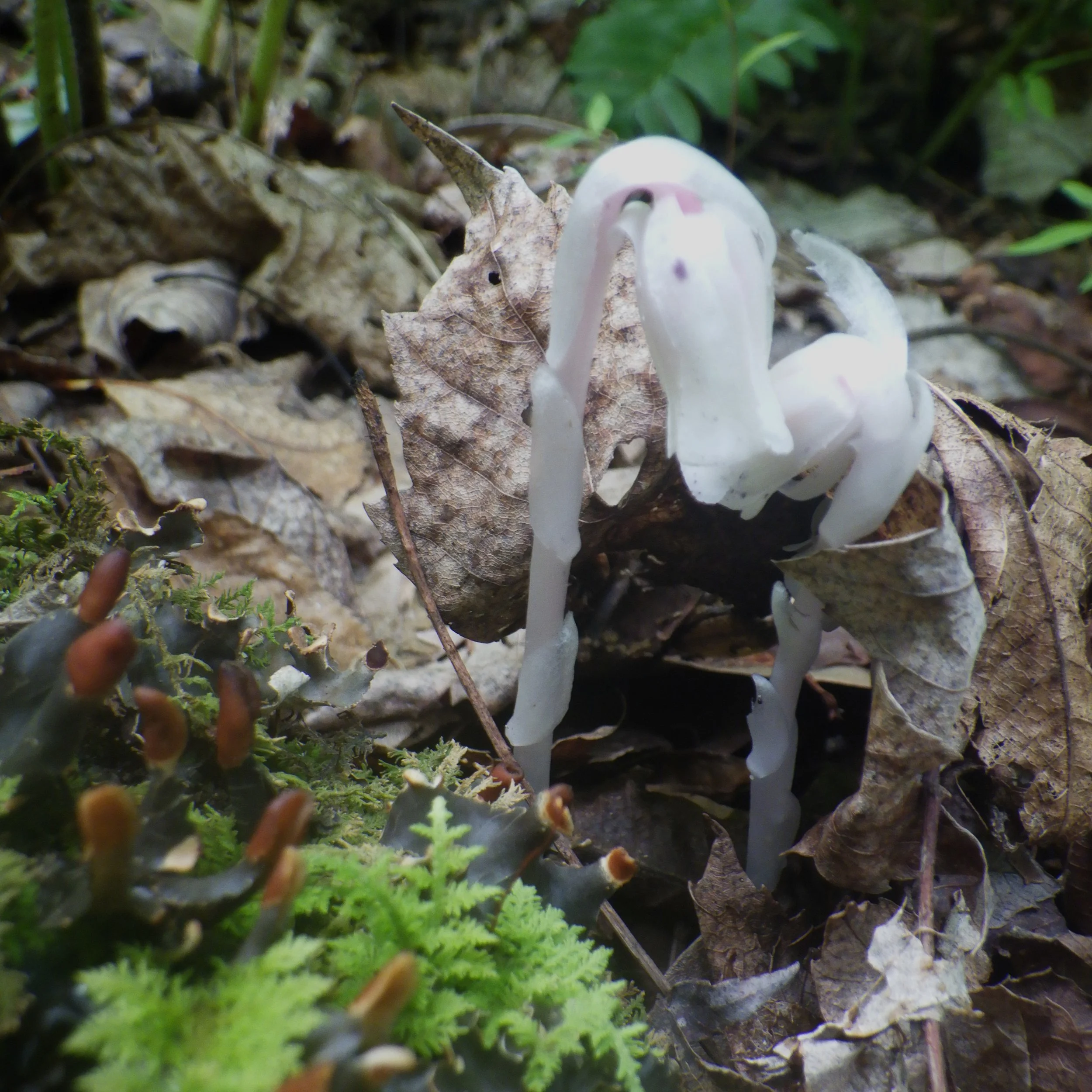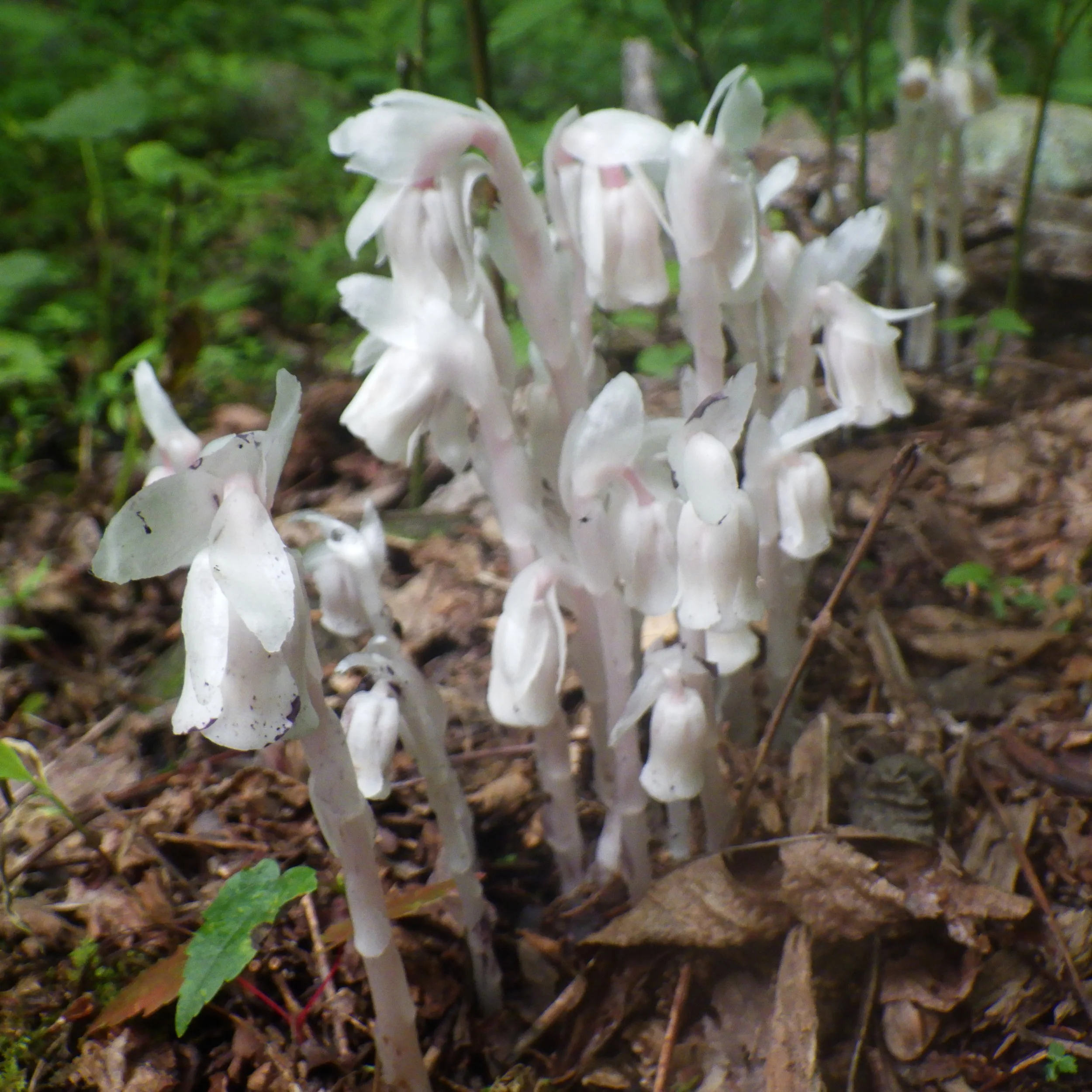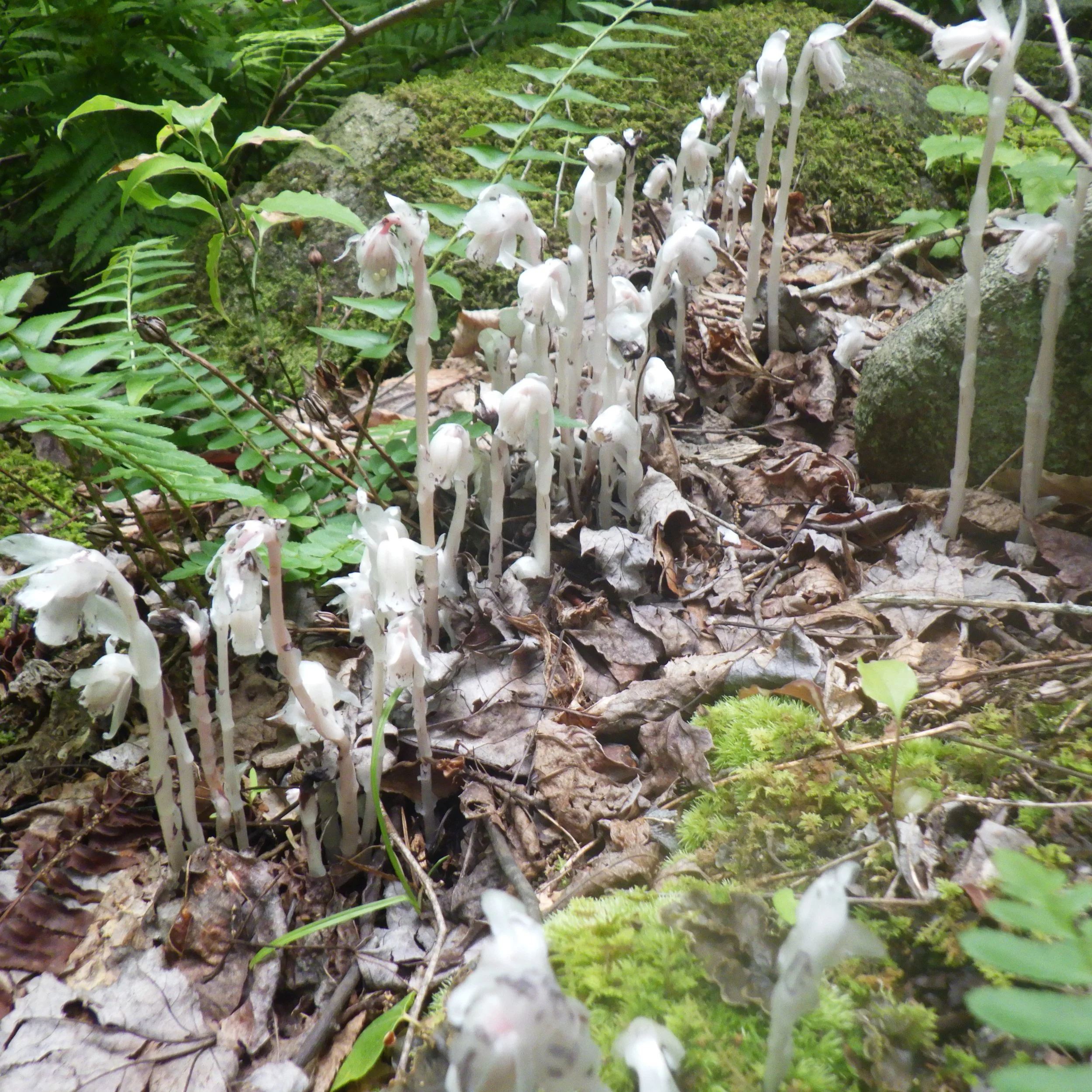
THE MYSTERIOUS REALM OF MYCOHETEROTROPHIC PLANTS
BY VICTORIA MOYER
During the autumn time of year, there’s always much swooning over the dramatic changes in foliage colors, caused in part by the destruction of chlorophyll and the revealing of carotenoids and anthocyanin. Though I, too, delight in the blazing seasonal palette shift, I find my curiosity traveling towards those plants who never made chlorophyll in the first place. Well, perhaps an ancestor did make chlorophyll, but for some reason throughout their evolutionary process, these achlorophyllous plants ceased making their own food like their autotrophic relatives, likely traveling through a “mixotrophic” stage (where they can photosynthesize, but also obtain food from other sources) to eventually become either fully mycoheterotrophic or “parasitic.”
“Parasitic” plants receive their nutrition from other plants rather than making it themselves via photosynthesis. There are fully “parasitic” plants, such as our local Beechdrops (Epifagus virginiana) who rely entirely on the roots of nearby Beech trees. There are also partially “parasitic” plants (mixotrophic), such as Downy False Foxglove (Aureolaria virginica), who do photosynthesize but are also in close relationship with the roots of certain plants in order to meet their sustenance needs. In the case of Aureolaria, they are often categorized as “hemi-parasitic” on Oaks.
Image Descriptions, left to right: Beechdrops in Afton, VA in early fall; Ghost Pipe in Glass Hollow; Aureolaria flowering on Dobie Mountain in August
Mycoheterotrophic plants, on the other hand, rely on the mycelium of mycorrhizal fungus, who has a symbiotic relationship with nearby trees, to receive their nutrition. Fully mycoheterotrophic plants usually are highly specialized with the type of host fungus they associate with. One of the more commonly seen examples in our area is the glowing white Monotropa uniflora (Ghost Pipe), who has a relationship with either Russula, or in fewer cases, Lacatarius fungal species. In the early fall, I found the enchantingly beautiful Pinesap (Hypopitys monotropa), which catalyzed my deeper curiosity on this topic. Pinesap apparently only relates with Tricholoma species. Regarding this fungus, Steve Trudell writes: “It is believed that all tricholomas are ectomycorrhizal or, in some cases, arbutoid mycorrhizal, forming a mutually beneficial association with many trees, some shrubs, and possibly even some herbaceous plants. Thus, they are nearly always found where trees are present, most often in forests and parks. Among the trees known to partner with tricholomas are Oak, Beech, Birch, Willow, Aspen, Cottonwood/Poplar, Pine, Spruce, Fir, Hemlock, and Douglas-Fir. Beyond their association with forest trees, not much is known about the habitat requirements of tricholomas. However many of them, such as the matsutake, occur in very nutrient-poor soils such as those with a high proportion of quartz sand.”
Image Description: Pinesap, with seed capsules, photographed in early fall in Afton, VA, growing on the same slope as the Beechdrops
Mycoheterotrophy seems to have evolved around 40 times in different plant lineages. Ericaceae and Orchidaceae are the more commonly studied groups, but there are over 400 species spanning a number of different families. Both Pinesap and Ghost Pipe, who are relatives of one another, are in the Ericaceae family along with familiar photosynthetic kin such as Blueberries, Wintergreen, Mountain Laurel, and many others. As Merckx and Freudenstein write, “The vast majority of land plants are mycorrhizal and therefore it may not be surprising that a mycoheterotrophic mode of life has evolved, almost without exception, at least once in all of the major land plant lineages.” Some general similarities of physical characteristics among mycoheterotrophic plants include: reduction in vegetative parts and absence of stomata (pores for gas exchange), great number of light and tiny seeds (sometimes dust-like), and “change in function from organs of absorption to organs of storage, shown by the almost universal loss of root hairs, decrease in surface area as exhibited in short cylindric 'vermiform' and tuberous roots or, in extreme cases, the complete suppression of roots and the formation of a swollen tuber or rhizome” (Leake). With their lack of chlorophyll, they can often appear “otherworldly” compared to other plants, and sometimes even be confused for a mushroom.
While there are over 200 completely achlorophyllous (and therefore fully mycotrophic) orchid species, many of the chlorophyllous species still exhibit initial and partial mycoheterotrophy. Not only do the dust-like seeds require a nutrient supply from mycorrhizal fungus for germination, but even the mature plants were found to acquire carbon through photosynthesis as well as fungal origins. McCormick et al also discovered that “both shade and drought increased the dependence of both Orchids [Goodyera pubescens and Tipularia discolor] on mycoheterotrophically derived carbon and nitrogen.” These are both common Orchids found in our region.
Image Description: Goodyera pubescens, Afton VA November 2024 (on left); Russula sp., partner of Ghost Pipe (on right)
Contemplating the achlorophyllous mycotrophs in particular feels somehow seasonally relevant. They live the majority of their life in the dark underground, associating closely with the mycelial network who synthesizes much communication of the rhizosphere, sometimes even staying dormant for years before sending up a flowering stalk. They are liminal, in that they seem to live in multiple worlds and traverse thresholds others may be unaware of or unable to cross. We are well past the Autumn Equinox now, the days noticeably shorter and the nights longer and longer. Many perennial plants are sending their energy downwards into their roots for the winter. Z. Hudelot writes:
“There was once a time, before the formation of the Cascades and before Japan became islands, in which our mammalian ancestors lived, adapted, and survived in darkness. The artifacts of that subterranean time exist in our night vision, our susceptibility to UV damage, and the distinct lack of dangerous non-avian dinosaurs lurking about. Sixty-five million years ago immense heat spread across the Earth, then a lingering smoky umbra in its wake. Our early ancestors crawled into the waters and dark earth to feed on what lie there and to wait. Like the mycoheterotrophs, our radical adaptability enabled us to survive without sun in the Netherworld. In times uncertain and fraught, may we remember that ancient darkness in our bones and know that life is resilient.”
You may have noticed I often used quotes around the term “parasitic” to describe certain plants. I have done this is to emphasize that this language is approximate, and that the mechanisms of so-called parasitism within the plant realm may differ enough from what we call “parasitism” in the animal and protozoa realms that someday we may develop more precise language for the relationships. It also seems like all critters labeled “parasites” get a bit of a stigma or negative bias. For instance, I’ve seen many an article calling mycoheterotrophs “cheaters”, “stealers”, “thieves”, “freeloaders”, and worse. Likely our limited and often binary human-centered forms of ethics simply do not apply to broader ecological realities.
Scientists used to think mycotrophs were saprophytes (feeding directly on decaying matter), after all. You can still find books and articles out there calling Monotropa a saprophyte. We are always learning and adjusting our understanding of the world, and I think it’s fair to muse that Western science may not yet (and may never, given the limited realms of possible data it examines) fully understand the logic or the full ecological implications of mycoheterotrophy. Boundaries between categories of beings may be blurrier than taxonomic models suggest, and we may not have the tools to map all the possible layers of interaction between beings. In Bjorkman’s Pinesap experiments, he isolated the fungus that grows on the roots on Pinesap and cultivated it in a lab. When he added extracts of Pinesap, he found that it stimulated the fungus to grow more. Bidartondo et al found a similar result in regards to the relationship between the mycoheterotrophic “Snow Plant” (Sarcodes) and Rhizopogon fungus - the plant seemed to stimulate more growth of the fungus. This may not necessarily mean the plant is benefitting the fungus, but these findings at least open an inquiring door towards deeper understanding of complex relationship dynamics. We also have no evidence that the “parasitism” of mycoheterotrophy harms either the fungus or the tree species involved.
As we have seen, mycoheterotrophic plants indicate the strong presence of fungal networks, whether we can see the fruiting mushroom bodies at that time or not. For this reason, their presence can be useful grounds for habitat protection/regulations, since these fungal relationships are part of a delicate balance not easy or potentially possible to recreate. Furthermore, they cannot be propagated outside of their needed ecosystem, so we must take care of them where they grow. While I think it is very valuable to propagate and plant native plants when it is possible to do so, I would argue it is even more important to protect existing habitat from over-development and destruction.
Lastly, some mycotrophs have long histories of medicinal use, which can often help us more deeply understand the personhood of a plant and their way of being in the world from a different point of view. Ghost Pipe, in particular, has received quite a bit of fame in our bioregion for this reason. And while I am a proponent of humans learning this information, I appreciate this perspective from herbalist Sean Donohue:
“I understand why knowledge of a plant like Ghost Pipe spreads like wildfire. We live in a time when people feel cut off from the living world, and finding out about a strange, beautiful plant that taps into the mind of an entire forest brings a stir of recognition of the kind of connection the deepest parts of ourselves know is possible, even when we so seldom experience it in our lives and our worlds.
And I understand why so many feel the need to harvest the plant for themselves or buy the tincture from someone else. We live in a culture that has objectified and commodified everything. And in which the sense of our entitlement is magnified and the sense of our impact on the living world is diminished -- my own included, or I wouldn't be here writing this mea culpa. It can seem like the only way to access the magic Ghost Pipe represents to us is to hold something made of the body through which that magic moves.
I am not saying nobody should use Ghost Pipe as medicine. I am saying it should be used only when no other medicine will do, by people with enough knowledge to know that no other medicine will do, who have also cultivated a deep relationship with the plant.
For those who have come here seeking knowledge about this plant, here is what I suggest you do instead:
go to the forests, the fields, the deserts, the mountains
find strange and beautiful beings
make respectful loving relationships with them
and hold their medicine as close as you would hold a Beloved.”
References:
Bidartondo, Martin I. et al. “High root concentration and uneven ectomycorrhizal diversity near Sarcodes sanguinea (Ericaceae): a cheater that stimulates its victims?” American journal of botany 87 12 (2000): 1783-8 .
Björkman, E. (1960), Monotropa Hypopitys L. — an Epiparasite on Tree Roots. Physiologia Plantarum, 13: 308-327. https://doi.org/10.1111/j.1399-3054.1960.tb08034.x
Donohue, S. (2016, July 24). Ghost Pipe: A Cautionary Tale. Green Man Ramblings. https://greenmanramblings.blogspot.com/2016/07/ghost-pipe-cautionary-tale.html
Gebauer, G., Preiss, K. and Gebauer, A.C. (2016), Partial mycoheterotrophy is more widespread among orchids than previously assumed. New Phytol, 211: 11-15. https://doi.org/10.1111/nph.13865
Hudelot, Z. (2024). Ghosts of the Forest. In Viridis Genii: Explorations of the Green Arte (Vol. 4, Ser. 9, pp. 107–123). essay, Viridis Press.
Leah Bendlin of the Oregon Mycological Society. (2021). Marvelous Mycoheterotrophs: The Beauty and Science of Floral-Fungal Freeloaders. Retrieved from https://www.youtube.com/watch?v=J0wu_ZbUx-g.
Leake JR. The biology of myco-heterotrophic ('saprophytic') plants. New Phytol. 1994 Jun;127(2):171-216. doi: 10.1111/j.1469-8137.1994.tb04272.x. PMID: 33874520.
McCormick MK, Good KL, Mozdzer TJ and Whigham DF (2022) Shade and drought increase fungal contribution to partially mycoheterotrophic terrestrial orchids Goodyera pubescens and Tipularia discolor. Front. Ecol. Evol. 10:1047267. doi: 10.3389/fevo.2022.1047267
Merckx, V. and Freudenstein, J.V. (2010), Evolution of mycoheterotrophy in plants: a phylogenetic perspective. New Phytologist, 185: 605-609. https://doi.org/10.1111/j.1469-8137.2009.03155.x
Murray, E. (1970). The Downy False Foxglove. In In Nature’s Garden (p. 33). essay, Virginia Wildlife.
Sarah C. Watkinson, Chapter 7 - Mutualistic Symbiosis Between Fungi and Autotrophs, Editor(s): Sarah C. Watkinson, Lynne Boddy, Nicholas P. Money. The Fungi (Third Edition), Academic Press, 2016, Pages 205-243, ISBN 9780123820341, https://doi.org/10.1016/B978-0-12-382034-1.00007-4.
Taylor, D.L. (2004), Myco-heterotroph–fungus marriages – is fidelity over-rated?. New Phytologist, 163: 217-221. https://doi.org/10.1111/j.1469-8137.2004.01124.x
Trudell, S. (2012). The Genus Tricholoma in North America. FUNGI Magazine, 5(5), 23–31.










